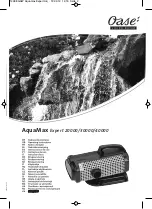
101-C00 Page 11/20
VANE REPLACEMENT
NOTICE:
Maintenance shall be performed by qualified technicians
only. Follow the appropriate procedures and warnings as
presented in manual.
1. Flush the pump per instructions in this manual. Drain and
relieve pressure from the pump and system as required.
2. Remove the head assembly from the
outboard
(nondriven) side of the pump according to steps 5 - 8 in
the "Pump Disassembly" section of this manual.
3. Turn the shaft by hand until a vane comes to the top (12
o'clock) position of the rotor. Remove the vane.
4. Install a new vane, ensuring that the rounded edge is UP,
and the relief grooves are facing towards the direction of
rotation. See Figure 4.
5. Repeat steps 3 and 4 until all vanes have been replaced.
6. Reassemble the pump according to the "Pump
Assembly." section of this manual.
Figure 4 – Vane Replacement
PUMP DISASSEMBLY
NOTICE:
Follow all hazard warnings and instructions provided in
the “Pump Maintenance” section of this manual.
1. Flush the pump per instructions in this manual. Drain and
relieve pressure from the pump and system as required.
2. Remove the four adapter capscrews (20C) to release the
adapter (135). Remove the motor mounting bolts. With
the aid of a lifting device, slide the motor and gearbox
away from the pump. Refer to “Gear Reducer
Maintenance” for reducer disassembly instructions.
3. Starting on the
inboard
(driven) end of the pump, clean
the pump shaft thoroughly, making sure the shaft is free
of nicks and burrs. This will prevent damage to the
mechanical seal when the inboard head assembly is
removed.
4. Remove the outboard bearing cover capscrews (28) and
the outboard bearing cover (27) and bearing cover gasket
(26). Discard the bearing cover gasket.
5.
The GNX(H)2, 2.5, and 3
are equipped with locknuts
(24A) and lockwashers (24B). To remove:
a. Bend up the engaged lockwasher tang and rotate the
locknut counterclockwise to remove it from the shaft.
b. Slide the lockwasher off the shaft. Inspect the
lockwasher for damage and replace as required.
c. Repeat steps a and b on the opposite shaft end.
6. GNX(H)4 pump models are equipped with bearing lock
collars (24A). To remove:
a. Remove the jam nuts (24C) and loosen the two set
screws (24B).
b. Slide the lock collar off the shaft.
c.
Repeat steps a and b on the opposite shaft end.
7. Remove the head capscrews (21). Gently pry the head
away from the cylinder.
8. Slide the head off the shaft. The head O-ring (72),
bearing (24), and mechanical seal (153) will come off with
the head assembly. Remove and discard the head O-
ring.
a. Pull the bearing (24) from the housing in the head.
b. To remove the mechanical seal, use two screw
drivers against the backside of the seal jacket to
gently push the seal from the head (see Figure 5.
Use care when placing the screw drivers to prevent
damage to the seal faces. Remove and discard the
seal O-rings.
Figure 5 – Mechanical Seal Removal
9. Pull the rotor and shaft (13) from the cylinder. While one
hand is pulling the shaft, the other hand should be
cupped underneath the rotor to prevent the vanes (14)
and push rods (77) from falling out. Carefully set the rotor
and shaft aside for future vane replacement and
reassembly.
10. Remove the remaining components from the outboard
side of the pump, as instructed in steps 7 and 8 above.
PARTS REPLACEMENT
1. If any of the O-rings have been removed or disturbed
during disassembly, they should be replaced with new O-
rings.
NOTE:
PTFE O-rings should be heated in hot water to
aid installation.
2. Excessive or continuous leakage from the tell-tale hole in
the bearing cover may be an indication of a damaged
mechanical seal. If a mechanical seal has been leaking, it
is recommended the entire seal be replaced. Refer to
"General Pump Troubleshooting" for possible causes of
seal leakage.






































